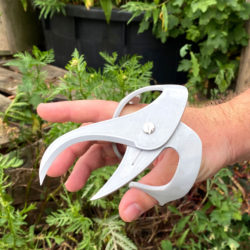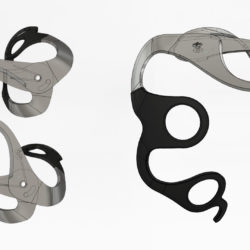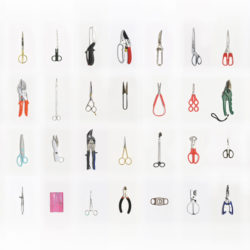Beak Shears
Description
The BEAK harvesting shears enable one-handed interaction by combining gripping and cutting. This special tool, developed for professional herb and salad harvesting, is the result of an extensive investigation of a cutting tool taxonomy as part of the bachelor thesis. From the examination of cutting tools, a fifty-part collection of scissors was created at the beginning, from which a construction kit for new cutting concepts was developed. All the knowledge gained was catalogued in a list of scissors. This additional product became both the key and the perspective of the final thesis: a solid basis for a new concept was created, combining the essentials of the collection with the needs found in the research.What is the Topic?
"Gripping tools using the example of scissors" is the title. Special tools are rarely operated purely intuitively. It takes a lot of practice to gain mastery over such a tool. Over time, a lot of experience will lead to automation in operation. Only when the tool, in this case the harvesting shears, recedes into the background of our consciousness is it possible to grasp the tool completely with hand and brain. Smooth interaction with the tool takes place and the user can fully concentrate on the execution of the work. The field research carried out in the narrower sense showed the need for efficient, more advanced cutting tools in manual herb harvesting, which allows double use through one-handed use. This is because machines are not suitable for certain harvesting methods. Professional harvesting tools are still needed because people still carry out work that cannot be automated and taken over by machines. The harvesting person must therefore be optimally supported in his work. The product must therefore be ergonomic and cooperate with the user.
Why does it look like this?
The shape of the harvesting shears is based on technical, functional and user-oriented requirements. The developed repertoire of the scissors catalogue allows the scissors design to be weighed up according to these criteria: - To prevent the wrist from being over-twisted, the cutting plane must be inclined by 15 degrees to the finger. - An asymmetrical cutting head with a curved navigation tip, as is the case with scythes, is used for better navigation between the vertically growing plant stems. The longer tip serves as a guide. Concave inner cutting edges prevent the stalks from slipping out. The cigar scissors from the scissors collection served as a model for this. - In addition, a bypass cut prevents the cut material from being crushed, as two sharp blades shear against each other. - The length of the blades also depends on the function. If the blades were longer than the diameter of the bundle to be gripped, you would cut off more than you can grip. - The distance between the hand and the cutting plane serves as a safety distance on the one hand and as a parallel cutting offset on the other. - A concealed oblong hole between the two blades with a circular course provides blade tension and limits the opening angle of the blades. - A springy performance for pleasant, often repeated cuts. - The little finger supports the closing by resting on a finger hook as known from hairdressing scissors. - The tool handles are dipped in rubber at the end of the production process for better wearing comfort.
What is special?
A cutting tool that requires only one hand for the entire interaction would create numerous advantages. The free hand could, for example, be used to hold the collection container during harvesting or to hold on to the ladder, thus increasing safety. Other considerations: It would be possible to equip both hands with scissors and thus work two-handed in rows of greenhouses or in confined spaces such as vertical farms. The development of such a tool would also benefit one-handed people, as they would be able to grip, hold and cut with the same hand.
What is new?
Until now, in order to enable single-handed harvesting with a cutting tool, the gripping of the crop and the cutting process had to be separated in time. With some types of cuttings, this is not possible without other aids - for example, binding material - or only if the crop is damaged. The combined gripping and cutting process makes this possible with BEAK. The procedure to be learned is as follows: The middle finger, which has more freedom of movement than the other fingers due to the missing scissors eye, grasps the herb band with the thumb. Only then do the other fingers follow the middle finger to make the cut.




